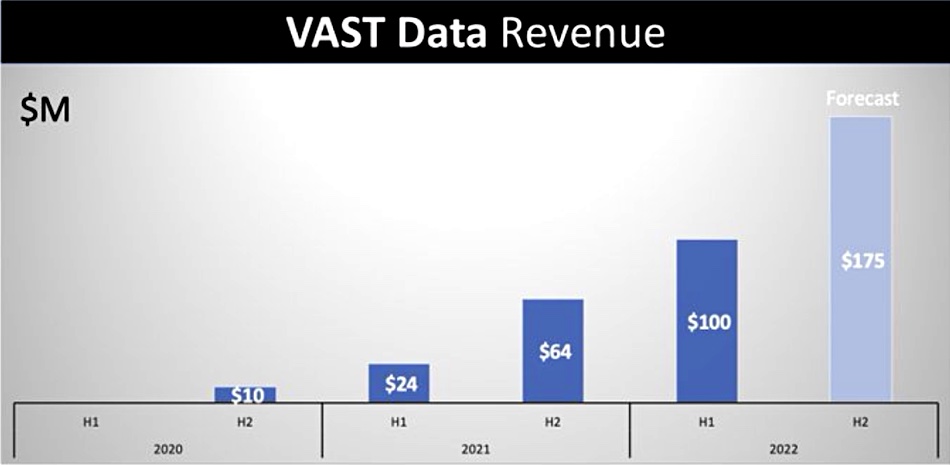Taiwan-based Ambedded Technology has released the UniVirStor Flash Mars500 Ceph Storage Appliance: software-defined storage integrating Ceph, Ampere Altra Arm servers, and Ambedded’s Ceph management web UI. This turn-key appliance is supposed to simplify the deployment, operation, management, and monitoring of a Ceph storage cluster. The Mars500 comes with UVS manager v3 which enables storage admins to deploy, monitor, and manage the ceph cluster via a GUI and automated processes without using any command lines. Features include a redesigned dashboard, host management, CRUSH map, RBD snapshot schedules, mirroring, and multi-site object storage.

…
Real-time data platform provider Aerospike has released version 6 of its software, running on AWS Graviton2-powered Amazon Elastic Compute Cloud (Amazon EC2) instances. Detailed in a new benchmark report, “Achieve Exceptional Price-Performance for Real-time Workloads with Aerospike and AWS Graviton2”, it is claimed to deliver price-performance benefits of up to an 18 percent increase in throughput while maintaining up to 27 percent reductions in cost. The test measured AWS Graviton2–powered Amazon EC2 instances versus comparable x86-based instances running Aerospike 6, with 99 percent of the transactions completed in 1 millisecond or less. (Source: Hakha Momeni, AWS Graviton Price-Performance Calculations.)
…
Data manager Datadobi’s latest StorageMAP 6.3 release has introduced the means to copy network-attached storage (NAS) data to any S3-compatible object storage system or service within different geographies, tech stacks, or networking providers. This functionality adds to StorageMAP’s ability to help IT staff archive, pipeline, and replicate file data to S3.
…
DDN has revealed at SC22 a Reference Architecture (RA) built in collaboration with Atos, alongside enhancements to its scalable and flexible monitoring interface, DDN Insight, which is intended to streamline and simplify management and support of HPC and AI infrastructures at-scale. The RA uses DDN’s parallel filesystem A3I AI400X2 appliances to deliver data with high-throughput, low-latency and massive concurrency for processing by Atos BullSequana XH3000 systems. Or so it says on the tin.
…
DH2i has released DxEnterprise (DxE) v22, featuring a new container sidecar to enable application-level high availability (HA) clustering for stateful containers in Kubernetes (K8s). This DxE v22 sidecar delivers a separate container that can run alongside an application container in a Kubernetes pod. It delivers isolation – the primary application can run independently in one container while the DxE sidecar hosts complementary HA clustering services. It also provides quick deployment and scalability, DH2i said.
…
Enterprise file collaborator Egnyte has redesigned its web UI for better readability. Its Desktop App Core is built on Apple’s new File Provider framework, is easy to deploy on M1 and M2-based Macs, and is tightly integrated with macOS, the vendor said. With snapshot-based ransomware recovery teams can now mount and remount snapshots in an easier and more intuitive way. Egnyte’s AEC package has Smart Upload to help users organize and access construction photos faster. For life sciences users Controlled Document Management enables source document download in the original file format and exporting a list of documents to a CSV format file. It has also increased its focus on assisting companies with Cybersecurity Maturity Model Certification (CMMC).
…
SaaS data protector HYCU has added support for Azure Government Cloud and cross-cloud migration in its latest Protégé release. This provides customers the ability to spin up applications on Azure Government Cloud in one click, protect data on commercial and government clouds, and spin down the data to local on-prem infrastructure, HYCU told us. Customers can use Protégé for cost-effective disaster recovery into AWS. Whether leveraging AWS as a backup target or protecting AWS native workloads, HYCU Protégé now enables customers to failover into AWS. It minimizes AWS infrastructure cost with on-demand disaster recovery, only spinning up resources when needed, the vendor claimed.
…
NVMe TCP storage supplier Lightbits Labs has announced that Germany-based x-cellent technologies will integrate its storage into their metalstack.cloud infrastructure. The metalstack.cloud targets customers and developers needing a secure tech platform to run Kubernetes for manufacturing, software and consulting companies, and startups.
…
Open source database supplier MariaDB’s SkySQL product is being used by Certified Power Solutions (CPS). CPS’s winter road maintenance system for snowplow trucks collects data every five seconds from 5,000 vehicle sensors to inform local agencies about their salt use for de-icing roads and keeping communities safe. CPS increased the number of users they could support by over 3,000 percent overnight after switching to SkySQL, MariaDB said. And CPS also saved over 60 percent of its total cost for databases by migrating to SkySQL, it claimed.
…
Serverless database supplier PlanetScale has launched PlanetScale Boost, which improves query performance by more than 100x and eliminates the need for external database caching. PlanetScale said it sits next to, but apart from, the database, and operates transparently with no transactional overhead and none of the risk to stability of the platform that traditional caches introduce. Boost uses VStream technology from Vitess, and is accessed from PlanetScale Insights in the web UI, for picking and choosing the most important queries that need to execute faster. Selected queries are automatically accelerated behind the scenes until they are deselected.
…
Scale-out filesystem supplier Qumulo is partnering with HPE, which has announced new hybrid-NVMe solutions today featuring Qumulo software on HPE Apollo 4200 Gen10 Plus servers. Qumulo and HPE customers now can choose all-NVMe for performance and hybrid-NVMe for general purpose and archive use cases. This hybrid NVMe platform, according to the sales pitch, can serve massive workloads with significant NVMe performance gains while lowering cooling and space usage. In addition, HPE GreenLake with Qumulo provides as-a-service consumption.
…
Data protector and security biz Rubrik has announced Rubrik Cyber Recovery. Available as part of the Rubrik Security Cloud, it delivers two capabilities to help organizations prepare for attacks and minimize operational downtime. It provides a simple way to test, validate, and document the success of an organization’s cyber recovery plans. It also provides businesses a way to instantly recover the last known clean copy of data into production while performing forensic investigations out-of-band in an isolated recovery environment.
…
There is a new Spectrum Scale Tile for IBM Cloud in the IBM Catalog. It allows you to deploy storage clusters that use Spectrum Scale as storage on top of an IBM Cloud VPC compute configuration. This uses open source Terraform-based automation to provision and configure IBM Cloud resources. IBM claims that, with simple steps to define configuration properties and use automated deployment, you can build you own high-performance storage cluster in minutes.
…
StorMagic’s SvSAN has been validated with the HPE ProLiant MicroServer Gen10 Plus platform. It delivers a robust, powerful all-in-one architecture for edge computing environments, with no server rack required. SvSAN runs on any hypervisor as a guest virtual machine to enable complete, highly available shared storage and virtualization with only two MicroServer servers per site. Its shared storage executes active-active synchronous mirroring to create a copy of data on both servers, eliminating downtime.
…
All-flash scale-out filer supplier VAST Data has won a 30PB-plus deal at the US Department of Veterans Affairs’ (VA) Million Veterans Program (MVP) to store generic data. The VAST system will accelerate the VA’s high-performance computation (HPC) and genome data analysis workloads, it said. Projects using MVP data are already underway across the VA and cover subjects ranging from mental health to heart disease. MVP leaders are working with the Department of Defense, the National Institutes of Health, and the Department of Energy to further expand the program and optimize its impact.
…
LinkedIn poster Soothsawyer says that, up to 1H2022, privately owned and VC-funded VAST Data has generated about $200 million in revenue and is on track to add another $175 million for 2H2022. By the end of 2022, VAST will have pulled in a total of $375 million.

Read his post to understand how he’s worked this out from qualiatative statements by VAST and revenue numbers from Pure and Nutanix which VAST has referenced.
…
Versity Software, provider of mass storage and large archive data management systems, announced that a 60PB mass storage setup for NCSA at the University of Illinois Urbana-Champaign, has been procured, tested, and fully deployed. The system is driven by Versity’s Scale Out Archive Manager (ScoutAM) platform and provides researchers with access to archival data using open standard protocols and automates complex workflows, while enabling responsive metadata searches and queries. ScoutAM runs on 5 Dell R730 nodes which manage a 2.6PB high performance data cache and a large tape library. Globally accessible cluster export nodes allow researcher access to the system directly via tools such as scp, Globus, and S3. All tape IO is parallelized across 34 tape drives with 60 PB of data in the library, and headroom for more storage over time.
…
VMware has announced Tanzu Kubernetes Grid 2.1, which introduces support for Oracle Cloud Infrastructure, in addition to existing support for AWS, Azure, and vSphere. This is intened to give customers more choice and consistency in deployments in their multi-cloud uses.
…
Israeli startup Xinnor has said xiRAID, its software RAID engine, runs on Linux and supports NVMe drives and NVMe-oF-accessed drives (think of mdraid or zfs on steroids). Xinnor claimed it’s faster than any other RAID on the market without hardware acceleration, even GPU-powered RAID hardware card acceleration (think GRAID). The software includes I/O handling parallelization and lockless datapath. Installed xiRAID arrays have very small RAID penalties and perform very close (up to 97 percent in RAID 5) to the raw hardware capabilities of the drives. Xinnor said xiRAID works with block devices, local or remote, using any transport – PCIe, NVMe-oF or SPDK target, Fibre Channel or InfiniBand. And it provides a local block device to the system.








